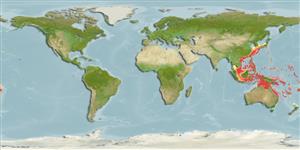Common names from other countries
Environment: milieu / climate zone / depth range / distribution range
Écologie
; profondeur 15 - 150 m (Ref. 100565). Tropical
Western Pacific: Hong Kong, Philippines, and New Caledonia.
Length at first maturity / Taille / Poids / Âge
Maturity: Lm ? range ? - ? cm Max length : 3.0 cm ShH mâle / non sexé; (Ref. 821)
Description synthétique
Morphologie
Shell translucent with yellow tips. Body creamy white with dark red spots.
Length based on occurrence record; to be replaced with better reference. Maximum depth from Ref. 100566. Commensal with Euplexaura curvata (Ref. 126204).
Life cycle and mating behavior
Maturité | Reproduction | Frai | Œufs | Fécondité | Larves
Members of the order Neotaenioglossa are mostly gonochoric and broadcast spawners. Life cycle: Embryos develop into planktonic trocophore larvae and later into juvenile veligers before becoming fully grown adults.
Springsteen, F.J. and F.M. Leobrera. 1986. (Ref. 821)
Statut dans la liste rouge de l'IUCN (Ref. 130435)
statut CITES (Ref. 108899)
Not Evaluated
Not Evaluated
Utilisations par l'homme
| FishSource |
Outils
Sources Internet
Estimates based on models
Preferred temperature
(Ref.
115969): 24.3 - 28.2, mean 26.6 (based on 93 cells).
Vulnérabilité
Low vulnerability (10 of 100).
